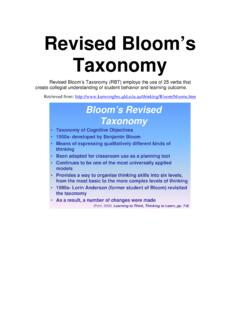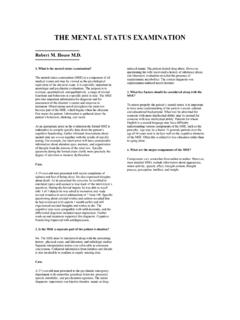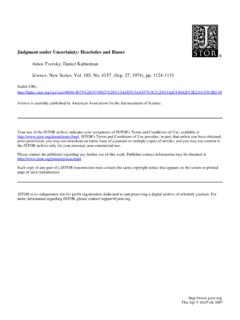Transcription of DEPRESSION LITERATURE REVIEW F ISK - World Health …
1 POSTPARTUM DEPRESSION : LITERATURE REVIEW OF RISK FACTORS AND INTERVENTIONS Donna E. Stewart, MD, FRCPC E. Robertson, , PhD Cindy-Lee Dennis, RN, PhD Sherry L. Grace, MA, PhD Tamara Wallington, MA, MD, FRCPC University Health Network Women s Health Program 2003 Prepared for: Toronto Public Health October 2003 Financial assistance by Health Canada Women s Health Program Toronto Public Health Advisory Committee: Jan Fordham, Manager, Planning & Policy Family Health Juanita Hogg-Devine, Family Health Manager Tobie Mathew, Health Promotion Consultant Early Child Development Project Karen Wade, Clinical Nurse Specialist, Planning & Policy Family Health Mary Lou Walker, Family Health Manager Karen Whitworth, Mental Health Manager Copyright: Copyright of this document is owned by University Health Network Women s Health Program.
2 The document has been reproduced for purposes of disseminating information to Health and social service providers, as well as for teaching purposes. Citation: The following citation should be used when referring to the entire document. Specific chapter citations are noted at the beginning of each chapter. Stewart, , Robertson, E., Dennis, C-L., Grace, , & Wallington, T. (2003). Postpartum DEPRESSION : LITERATURE REVIEW of risk factors and interventions. 1 POSTPARTUM DEPRESSION : LITERATURE REVIEW OF RISK FACTORSAND INTERVENTIONST able of ContentsEXECUTIVE SUMMARY2 OVERALL METHODOLOGICAL FRAMEWORK5 CHAPTER 1: RISK FACTORS FOR POSTPARTUM DEPRESSION9 Emma Robertson PhD, Nalan Celasun PhD, Donna E. Stewart MD FRCPCCHAPTER 2: DETECTION, PREVENTION AND TREATMENT OF POSTPARTUM DEPRESSION 71 Cindy-Lee Dennis RN PhDCHAPTER 3: THE EFFECT OF POSTPARTUM DEPRESSION ON THE MOTHER-INFANTRELATIONSHIP AND CHILD GROWTH AND DEVELOPMENT 197 Sherry L.
3 Grace PhD, Stephanie Sansom MACHAPTER 4: PUBLIC Health INTERVENTIONS AND STRATEGIES WHICH REDUCE ORMITIGATE THE IMPACT OF POSTPARTUM DEPRESSION ON THE MOTHER-INFANTRELATIONSHIP AND THE GROWTH AND DEVELOPMENT OF CHILDREN 252 Tamara Wallington MD FRCPCAPPENDIX A: SEARCH TERMS USED TO IDENTIFY LITERATURE 281 APPENDIX B: LIST OF DATABASES 282 APPENDIX C: LIST OF KEY JOURNALS (REVIEWED FOR LAST 2 YEARS) 283 APPENDIX D: SEARCH STRATEGY 285 CONTRIBUTORS 286 2 EXECUTIVE SUMMARY This Postpartum DEPRESSION LITERATURE REVIEW of Risk Factors and Interventions, commissioned by Toronto Public Health , is a comprehensive REVIEW of the LITERATURE from 1990-2002 in four related areas: 1) risk factors for postpartum DEPRESSION , 2) its detection, prevention and treatment 3) the effects of the illness on the mother- infant relationship and child growth and development and 4) public Health interventions and strategies which reduce or mitigate the impact of postpartum DEPRESSION on the mother-infant relationship and the growth and development of children.
4 This report critically evaluates the LITERATURE , lists gaps and formulates conclusions based on the best available current evidence. OVERALL MESSAGES DEPRESSION is a major public Health problem that is twice as common in women as men during the childbearing years. Postpartum DEPRESSION is defined within this report as an episode of non-psychotic DEPRESSION according to standardized diagnostic criteria with onset within 1 year of childbirth. 1. RISK FACTORS FOR POSTPARTUM DEPRESSION Research studies have consistently shown that the following risk factors are strong predictors of postpartum DEPRESSION : DEPRESSION or anxiety during pregnancy, stressful recent life events, poor social support and a previous history of DEPRESSION .
5 Moderate predictors of postpartum DEPRESSION are childcare stress, low self-esteem, maternal neuroticism and difficult infant temperament. Small predictors include obstetric and pregnancy complications, negative cognitive attributions, single marital status, poor relationship with partner, and lower socioeconomic status including income. No relationship was found for ethnicity, maternal age, level of education, parity, or gender of child (in Western societies). 2. DETECTION, PREVENTION AND TREATMENT While postpartum DEPRESSION is a major Health issue for many women from diverse cultures, this condition often remains undiagnosed. Although several measures have been created to detect depressive symptomatology in women who have recently given birth, the development of a postpartum DEPRESSION screening program requires careful consideration.
6 Evidence-based decisions need to be made regarding: (1) the most effective screening test that not only has good sensitivity and specificity, but is quick, easy to interpret, readily incorporated into practice, and culturally sensitive; and (2) Health care system issues such as cost-effectiveness, potential harm, and policies for referral. Auspiciously, preliminary research suggests postpartum DEPRESSION is amenable to treatment interventions thus providing a rationale for the development of a screening program. However, few well-designed randomized controlled trials have been conducted to effectively guide practice and policy recommendations and further research is required before evidence-based programs are widely implemented.
7 One certainty is that there is no single aetiological pathway by which women develop postpartum DEPRESSION , thus it is improbable that a single preventive/treatment modality will be effective for all women. 33. THE EFFECTS OF THE ILLNESS ON THE MOTHER-INFANT RELATIONSHIP AND CHILD GROWTH AND DEVELOPMENT Current research suggests that postpartum DEPRESSION has salient but selective effects on the mother-infant relationship, and child growth and development. Young children of mothers with postpartum DEPRESSION have greater cognitive , behavioural, and interpersonal problems than children of non-depressed mothers. With regard to emotional growth and development, studies support an early effect of postpartum DEPRESSION on infant affect, but do not support longer effects.
8 Overall, it is exposure to prolonged episodes of postpartum DEPRESSION or to recurrent episodes of maternal DEPRESSION that are most likely to have long term effects on the child. 4. PUBLIC Health INTERVENTIONS AND STRATEGIES WHICH REDUCE OR MITIGATE THE IMPACT OF POSTPARTUM DEPRESSION ON THE MOTHER-INFANT RELATIONSHIP AND THE GROWTH AND DEVELOPMENT OF CHILDREN The potential adverse effect of postpartum DEPRESSION upon the maternal-infant relationship and child development reinforces the need for early identification and effective treatment models. Unfortunately, there are few studies of public Health interventions that can prevent or mitigate the impact of postpartum DEPRESSION on these outcomes. A few studies, of variable quality, have explored the impact of interventions such as home visiting, telephone counseling, interactive coaching, group interventions, and massage therapy.
9 The results of these studies are still very preliminary and must be interpreted with caution. Large, well-controlled longitudinal studies that specifically measure maternal-infant relations and child development are required. METHODOLOGY FOR REVIEW A critical LITERATURE REVIEW of English language peer-reviewed publications from 1990-2002 was undertaken by an academic research team at University Health Network Women s Health Program (see pp. 5-8 and Appendix D). A list of search terms, databases, key journals that were hand searched and search strategy is found in Appendices A to D. All relevant articles were critically appraised and their quality graded on levels of evidence and strength of recommendation based on standardized methodology developed by the Canadian Task Force on Preventive Health Care (see ).
10 CAVEATS Findings in this report are based on studies of variable size and quality which sometimes reach differing conclusions. Most were conducted outside of Canada and need to be interpreted and applied within a Canadian context. Only the studies published since 1990 and in English or with an English abstract were included. A rigorous effort was made through expert opinion and personal contacts to include early seminal studies. 4 The LITERATURE varied in terms of the quality of the sampling procedures employed. Issues of bias selection, lack of randomized frameworks and studies being under-powered to detect effects were common limitations. This may be a reflection of the difficulty in recruiting and retaining large samples for intervention studies, or the difficulty of obtaining longitudinal data on mother-child relationships and child development.

















